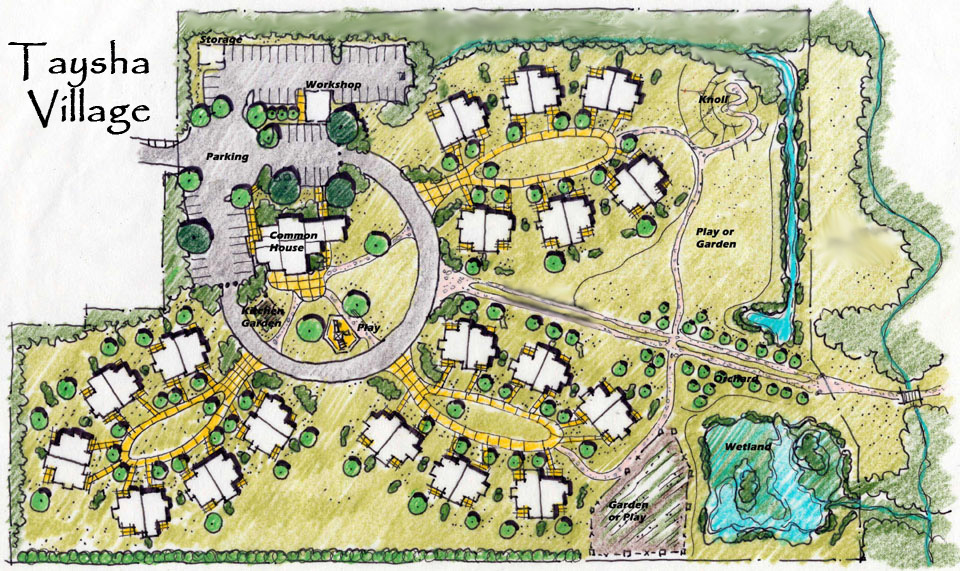About
Taysha Village and Food Production Facilities.
About Our Name
Before their land was gradually taken by European-Americans and the Osage, the Caddo Indians farmed, hunted and traded from villages established throughout the region. Parsons a Texas state archaeologist calls them a powerful people, revered by other Indians as “the father of tribes.”
In “Caddo Indians: Where We Come From,” historian Cecile Carter writes that “the Caddo appear to have been, even in the earliest times, very good diplomats, able to establish good relations with tribes along their borders.”
Carter traces the tribe’s earliest reference back five centuries, when Indians told Spanish explorers of a nation to the north with a strong sociopolitical structure, where “no one dared cross their borders without permission.”
In the late 1700s and early 1800s, the Caddo became a political force due to geography, positioned between the Americans and the Spanish in what would later become Texas. The state, incidentally, is named for the Caddo word for “friend,” pronounced “TAY-sha.”
Community Living
The theme of friendship is prominent in the modern-day Taysha Village, a 20-acre community of Tiny Homes where families live, work, and play together. The sense of community and camaraderie that Taysha Villages provide is not a new concept; people have been living in villages like this for thousands of years. Ironically, this type of community living is not seen as often in modern-day society.
The 10-acre village features a 4,000 square foot Common House, 36 Tiny Homes, and a traffic circle for vehicular access to the three circles where the homes are located. Golf carts are used instead of cars to quickly and efficiently get around the Village, and cars are parked in the main parking lot alongside the Common House.
Living in the community-oriented Taysha Village has many advantages, including a sense of belonging and feelings of meaning and purpose in one’s life. The Taysha Village is specifically geared toward homeless families and gently helps to reorient them to becoming productive members of society. The families who are supported here are those who have the desire to work and to improve their circumstances. Roughly 72 adults live in the Village, and the farm provides full-time jobs for about 60 of these individuals. The other adults work in the day-care and classroom that are situated in the Village’s Common House.
Hydroponic Farm Area
In the Village, the 5-acre farm food production systems where residents plant, harvest, and sell various food crops. The amount of crops they grow and sell is up to them; the more they work, the more produce they sell, resulting in higher incomes.
The farm area includes a greenhouse complex and commercial kitchen. The 2-3 acre greenhouse has the capacity to grow in excess of 60,000 pounds of produce per week. Employees process food items for sale in the state-of-the-art commercial kitchen. Tasks to prepare food items for sale include canning, packaging, and even baking. The fresh, local, sustainable produce is sold at a farm-stand on property as well as to grocery stores in the area.
Common House
The Common House is where meetings, events, and parties are held. P.O. boxes for all the residents are located here as well. A 1,000 square foot common area with dance floor is used for special events, but also doubles as a meeting space. A dining area with ten tables to accommodate larger groups and parties, as well as a kitchen space is included. The Common House also features two guest-bedrooms, which residents can reserve in advance for their house guests. For families who choose to home-school their children, a classroom and daycare is located in the Common House. This way, children can reap the social benefits of learning in a group setting, but also have the freedom of home schooling.
Living Space
Three circles with 12 homes each create a homey, welcoming village of 36 Tiny Homes. Each house has two bedrooms, one for the parents and one for their kids. The entire community comfortably supports 72 adults and their children. Interiors of each home are meticulously designed by Ms. Kim Lewis, the leading Tiny Home designer in the country, and feature all the amenities and upgrades a family would want or need. The 10-acre housing area encourages a sense of community with a recreation field to play sports, walking trails among tree-lined nature paths, a relaxation garden, fruit orchard, and additional garden space for families to grow even more plants. A kitchen garden is planted near the Common House to grow herbs and veggies that are easily accessible- no need to walk back over to the farm area to grab a handful of basil for a recipe!
Sustainable Living
A 5-acre Solar-Wind Farm will produce all of the power necessary for the entire village. Greenhouses will run entirely on Solar Windmills as well. All of EzGro’s most eco-friendly technologies will be incorporated into the greenhouse complex to make them among of the most sustainable food production systems in the world.
Taysha Village reestablishes values and trust, providing a unique opportunity for homeless families to get back on their feet in a safe and supportive environment. Residents learn from, teach, and nurture one another, which cultivates feelings of hopefulness and positivity. Children raised in this environment will grow up learning and using some of the most advanced sustainable technologies available on the market today, giving them a technological edge as they blossom into adults.
The Village

Food Production Facilities

Village Power Plant
[Best_Wordpress_Gallery id=”2″ gal_title=”Power Plant”]
[embedyt] https://www.youtube.com/watch?v=k-tI3vsWqLM[/embedyt]

